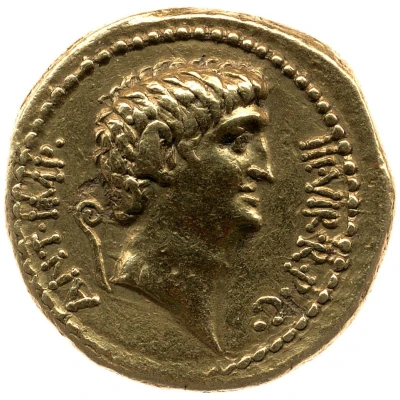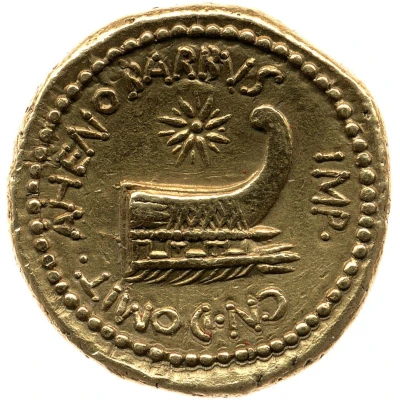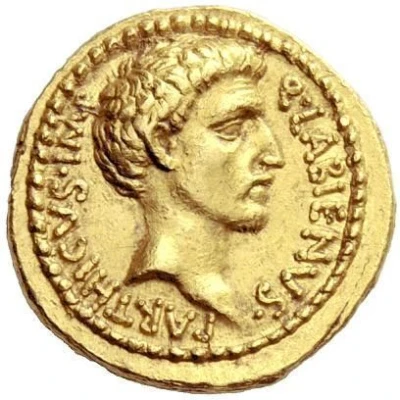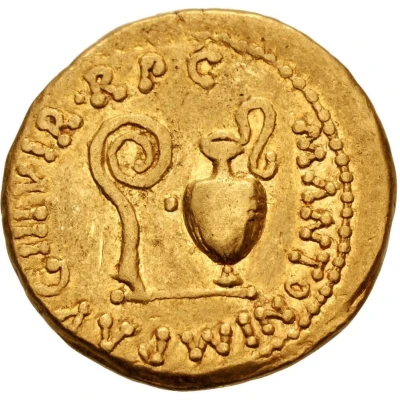
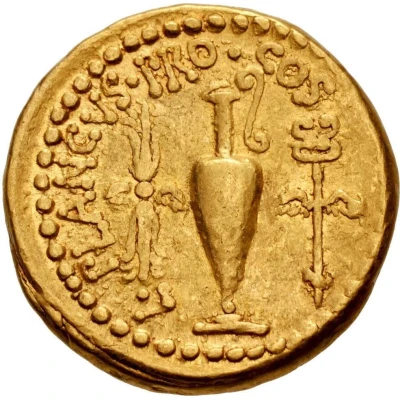

© Classical Numismatic Group, Inc.
Aureus - Marcus Antonius M·ANTON·IMP·AVG·III·VIR·R·P·C / L·PLANCVS·PRO·COS 40 BC
40 BC year| Gold | 7.58 g | 20 mm |
| Issuer | Rome › Roman Republic (509 BC - 27 BC) |
|---|---|
| Period | Republic (509 BC - 27 BC) |
| Type | Standard circulation coin |
| Year | 40 BC |
| Value | Aureus (25) |
| Currency | Denarius of 16 Asses (141 – 27 BC) |
| Composition | Gold |
| Weight | 7.58 g |
| Diameter | 20 mm |
| Shape | Round (irregular) |
| Technique | Hammered |
| Orientation | Variable alignment ↺ |
| Demonetized | Yes |
| Updated | 2024-10-06 |
| Numista | N#360753 |
|---|---|
| Rarity index | 100% |
Reverse
Thunderbolt, jug and caduceus.
Border of dots.
Script: Latin
Lettering: L·PLANCVS·PRO·COS
Comment
Lucius Munatius Plancus was a central figure in the political and military landscape of the late Republic and early Principate, and his career serves as a roll call of the famous names from this period. He had served as a legate of Julius Caesar during the Gallic War, and as proconsul of Transalpine Gaul from 44 to 43 BC. He fought with Caesar against Pompey during the Civil War and, after Caesar’s assassination, was encouraged by Cicero to oppose Antony. Following his participation in the War of Mutina in 43, against Decimus Brutus, Plancus held the consulship with Lepidus in 42, and allied himself with Antony, as evidenced by the striking of this aureus in 40 BC.Plancus participated in the Perusine War in 41-40 BC, where he assisted Lucius Antony in annihilating one of Octavian’s legions before fleeing to Greece with Mark Antony’s wife, Fulvia. Following the Peace of Brundisium, he served as proconsul of Asia where he fought against Quintus Labienus and the Parthian prince, Pacorus I. He later joined with Ahenobarbus to capture Sextus Pompey, before switching allegiance once again, perhaps because he was uncomfortable with Cleopatra’s growing influence over Antony, to Octavian in 32. Indeed, it was Plancus who proposed that Octavian take the name Augustus during the First Settlement of 27 BC.
Plancus died circa 15 BC in Gaeta, Italy where his tomb still stands, recording his career as Consul, Censor, twice Imperator and Septemvir Epulonum; a monument to a man whose political and moral flexibilities enabled him to live into old age at a time when many of his contemporaries succumbed to a more brutal end.
His coinage, from his first issues struck under Julius Caesar in 45 BC, all feature the distinctive, one-handled jug on the reverse, possibly symbolizing his membership of the priestly college of the Epulones. The iconography of this aureus follows that of the denarii of the same issue, featuring both the lituus and capis on the obverse, symbolizing Antony’s status as augur, and a thunderbolt and winged caduceus flanking the jug on the reverse. Within this issue, two different types exist variably naming Plancus as either Proconsul or Imperator Iterum. While examples of both are known for his denarii, the aureii are considerably rarer, with no examples of the PRO COS variety accounted for since two examples held in the Paris cabinet were lost in the robbery of 1831.
Interesting fact
One interesting fact about this coin is that it features a portrait of Marcus Antonius (Marc Antony) on one side, while the other side bears the image of a Roman consul, L. Plancius, which suggests that the coin was issued during a time when Antony was in a position of political power, possibly as a triumvir or consul.
